
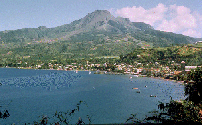 The infamous volcano of Mt. Pelée,
shown in this 1987 photo, looms over the village of St. Pierre
on the French Caribbean Island of Martinique. This sleepy little
village shows little of the grandeur of turn-of-the-century St.
Pierre, which was a vibrant colonial city, known to European tourists
as the "Paris of the West Indies." With its red-tiled
cottages, rambling streets, and tropical vegetation, this prosperous
little city was renowned for its beauty. In the official 1894
census, the population of St. Pierre was around 20,000. Although
most were native Martiniquans, the wealth and political power
were controlled largely by Creoles and a few French colonial officials
and civil servants. No one at the time could have predicted the
horror that was to descend on this tropical paradise with the
reawakening of Mt. Pelée in the Spring of 1902.
The infamous volcano of Mt. Pelée,
shown in this 1987 photo, looms over the village of St. Pierre
on the French Caribbean Island of Martinique. This sleepy little
village shows little of the grandeur of turn-of-the-century St.
Pierre, which was a vibrant colonial city, known to European tourists
as the "Paris of the West Indies." With its red-tiled
cottages, rambling streets, and tropical vegetation, this prosperous
little city was renowned for its beauty. In the official 1894
census, the population of St. Pierre was around 20,000. Although
most were native Martiniquans, the wealth and political power
were controlled largely by Creoles and a few French colonial officials
and civil servants. No one at the time could have predicted the
horror that was to descend on this tropical paradise with the
reawakening of Mt. Pelée in the Spring of 1902.
Although in January 1902 Mt. Pelée began to show an abrupt increase in fumarole activity, the public showed little concern. This changed, however, on April 23 when minor explosions began at the summit of the volcano. Over the next few days, St. Pierre was rocked by earth tremors, showered in ash, and enveloped in a thick cloud of choking sulfurous gas. These nightmarish conditions deteriorated further when the city and outlying villages were invaded by ground-dwelling insects and snakes driven from the slopes of Mt. Pelée by the ashfalls and tremors. Horses, pigs, and dogs screamed as red ants and foot-long centipedes crawled up their legs and bit them. Thousands of poisonous snakes joined the fray. An estimated 50 humans, mostly children, died by the snake bites, along with some 200 animals.
As the summit eruptions intensified, water in the Etang Sec crater lake was heated to near boiling. On May 5, the crater rim gave way, sending a torrent of scalding water cascading down the River Blanche. The hot water mixed with loose pyroclastic debris to generate a massive lahar with a downslope speed of nearly 100 kilometers per hour. This large volcanic mudflow buried everything in its path. Near the mouth of the river, north of St. Pierre, it overran a rum distillery, killing 23 workmen. The lahar continued into the sea, where it generated a three-meter-high tsunami which flooded the low-lying areas along the waterfront of St. Pierre.
Living near the volcano became increasingly stressful, leading many to consider leaving St. Pierre for Martinique's second city, Fort-de-France. On the day of the lahar, however, Governor Louis Mouttet received a report from a committee of civic leaders who climbed the volcano to assess the danger. The only scientist in the group was a local high school teacher. The report stated that "there is nothing in the activity of Mt. Pelée that warrants a departure from St. Pierre." It concluded that "the safety of St. Pierre is completely assured." The report eased the public's fears, and gave hope to city officials who were particularly anxious that voters remain in the city to cast their ballots for an election that was to be held on May 11. The only people with enough money to leave the island were the wealthy, nearly all of which belonged to the Progressive Party of Governor Mouttet. Mouttet convinced the conservative editor of the daily newspaper Les Colonies to downplay the danger of the volcano, and to lead the effort to encourage people to remain. Still, some residents left the city for Fort-de-France. This prompted Governor Mouttet to send in troops to patrol the road to Fort-de-France, with orders to turn back refugees who were trying to leave. Based on the soothing articles that appeared in Les Colonies, many people in the countryside flocked to St. Pierre thinking that it was the safest place to be. The population ballooned to about 28,000, nearly all of which would perish in the cataclysmic eruption of May 8.
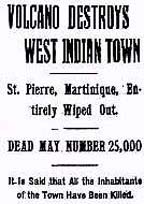 The election scheduled
for May 11 would not take place. The report issued by the investigating
committee on May 5, failed to realize the potential danger of
a large V-shaped notch cut through cliffs surrounding the summit
crater. The notch was like a colossal gun sight pointing directly
at St. Pierre four miles below. At about 7:50 a.m. on May 8, the
volcano erupted with a deafening roar. A large black cloud composed
of superheated gas, ash and rock rolled headlong down the south
flank of Mt. Pelée at more than 100 miles per hour, its
path directed by the V-shaped notch at the summit. In less than
one minute it struck St. Pierre with hurricane force. The blast
was powerful enough to carry a three-ton statue sixteen meters
from its mount. One-meter-thick masonary walls were blown into
rubble and support girders were mangled into twisted strands of
metal. The searing heat of the cloud ignited huge bonfires. Thousands
of barrels of rum stored in the city's warehouses exploded, sending
rivers of the flaming liquid through the streets and into the
sea. The cloud continued to advanced over the harbor where it
destroyed at least twenty ships anchored offshore. The hurricane
force of the blast capsized the steamship Grappler, and
its scorching heat set ablaze the American sailing ship Roraima,
killing most of her passengers and crew. The Roraima had
the misfortune of arriving only a few hours before the eruption.
Those on on board could only watch in horror as the cloud descended
on them after annihilating the city of St. Pierre. Of the ~28,000
people in St. Pierre, there were only two known survivors.
The election scheduled
for May 11 would not take place. The report issued by the investigating
committee on May 5, failed to realize the potential danger of
a large V-shaped notch cut through cliffs surrounding the summit
crater. The notch was like a colossal gun sight pointing directly
at St. Pierre four miles below. At about 7:50 a.m. on May 8, the
volcano erupted with a deafening roar. A large black cloud composed
of superheated gas, ash and rock rolled headlong down the south
flank of Mt. Pelée at more than 100 miles per hour, its
path directed by the V-shaped notch at the summit. In less than
one minute it struck St. Pierre with hurricane force. The blast
was powerful enough to carry a three-ton statue sixteen meters
from its mount. One-meter-thick masonary walls were blown into
rubble and support girders were mangled into twisted strands of
metal. The searing heat of the cloud ignited huge bonfires. Thousands
of barrels of rum stored in the city's warehouses exploded, sending
rivers of the flaming liquid through the streets and into the
sea. The cloud continued to advanced over the harbor where it
destroyed at least twenty ships anchored offshore. The hurricane
force of the blast capsized the steamship Grappler, and
its scorching heat set ablaze the American sailing ship Roraima,
killing most of her passengers and crew. The Roraima had
the misfortune of arriving only a few hours before the eruption.
Those on on board could only watch in horror as the cloud descended
on them after annihilating the city of St. Pierre. Of the ~28,000
people in St. Pierre, there were only two known survivors.
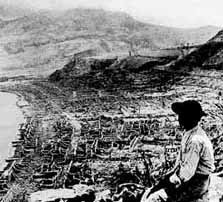
|
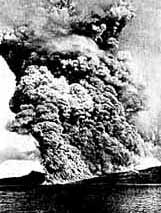 |
|
|
|
The dynamic cloud of hot gases and incandescent solid particles that destroyed St. Pierre was a pyroclastic flow, a feature that was unknown to science at the time. Subsequent examples observed on Mt. Pelée were described by French volcanologists as nuée ardentes, or glowing clouds.
Although there were only two survivors in St. Pierre, there were other survivors on the outskirts of the town and in some of the ships moored in the harbor. Mercifully, death came quickly to those that perished. Some may have died by the sheer force of the blast, but most died within a few seconds after inhaling the scorching fumes and ash of the pyroclastic flow. The throats and lungs of most of the deceased were seared and their bodies badly burned.
The tales of the two male survivors of St. Pierre are described briefly here, as well as the astonishing story of a young girl who looked straight into the mouth of a volcanic vent just before Mt. Pelée began to erupt.
A young shoemaker, Léon Compere-Léandre, was sitting on his doorstep when the nuée ardente hit. Although he was severely burnt he survived, partly because of his good health, but also because his house was near the edge of the pyroclastic flow. Here is his experience, in his own words:
| "I felt a terrible wind blowing, the earth began to tremble, and the sky suddenly became dark. I turned to go into the house, with great difficultuy climbed the three or four steps that separated me from my room, and felt my arms and legs burning, also my body. I dropped upon a table. At this moment four others sought refuge in my room, crying and writhing with pain, although their garmets showed no sign of having been touched by flame. At the end of 10 minutes one of these, the young Delavaud girl, aged about 10 years, fell dead; the others left. I got up and went to another room, where I found the father Delavaud, still clothed and lying on the bed, dead. He was purple and inflated, but the clothing was intact. Crazed and almost overcome, I threw myself on a bed, inert and awaiting death. My senses returned to me in perhaps an hour, when I beheld the roof burning. With sufficient strength left, my legs bleeding and covered with burns, I ran to Fonds-Sait-Denis, six kilometers from St. Pierre." |
 The only other known survivor in St. Pierre
became a minor celebrity. He was a husky 25-year-old roustabout
named Louis-Auguste Cyparis, locally known simply as "Samson".
In early April, Samson was put in jail for wounding one of his
friends with a cutlass. Towards the end of his sentence, he escaped
from a labouring job in town, danced all night, and then turned
himself into the authorities the following morning. For this,
he was sentenced to solitary confinement for a week in the prison's
dungeon. On May 8, he was alone in his dungeon with only a small
grated opening cut into the wall above the door. While waiting
for his breakfast, his cell became dark and he was overcome by
intense gusts of hot air mixed with ash that had entered through
the grated opening. He held his breathe while experiencing intense
pain. After a few moments, the heat subsided. He was severally
burned, but managed to survive for four days before he was rescued
by people exploring the ruins of St. Pierre. After he recovered,
he received a pardon and eventually joined the Barnum & Bailey
Circus, where he toured the world billed as the "Lone Survivor
of St. Pierre."
The only other known survivor in St. Pierre
became a minor celebrity. He was a husky 25-year-old roustabout
named Louis-Auguste Cyparis, locally known simply as "Samson".
In early April, Samson was put in jail for wounding one of his
friends with a cutlass. Towards the end of his sentence, he escaped
from a labouring job in town, danced all night, and then turned
himself into the authorities the following morning. For this,
he was sentenced to solitary confinement for a week in the prison's
dungeon. On May 8, he was alone in his dungeon with only a small
grated opening cut into the wall above the door. While waiting
for his breakfast, his cell became dark and he was overcome by
intense gusts of hot air mixed with ash that had entered through
the grated opening. He held his breathe while experiencing intense
pain. After a few moments, the heat subsided. He was severally
burned, but managed to survive for four days before he was rescued
by people exploring the ruins of St. Pierre. After he recovered,
he received a pardon and eventually joined the Barnum & Bailey
Circus, where he toured the world billed as the "Lone Survivor
of St. Pierre."
One of the most incredible escapes from Mt. Pelée was that of a young girl named Havivra Da Ifrile. Very early in the morning of May 8, Havivra was on her way to services at the catherdral in St. Pierre when her mother sent her on an errand. She was to walk to her aunt's pastry shop near a local tourist attraction known as the Corkscrew. The "Corkscrew" was named after a tourist trail that wound down into an ancient crater, or parasitic cone, located halfway up the flank of the volcano. As Havivra approached the Corkscrew, she noticed smoke rising from the crater. After looking into the crater, she described it in this manner: "There I saw the bottom of the pit all red, like boiling, with little blue flames coming from it." She apparently saw three people trying to run up the Corkscrew before they were engulfed in ". . . a puff of blue smoke . . " and ". . . fell as if killed." She fled toward St. Pierre.
| "Just as I got to the main street I saw this boiling stuff burst from the top of the Corkscrew and run down the side of the hill. It followed the road first, but then as the stream got bigger, it ate up the houses on both sides of the road. Then I saw that a boiling red river was coming from another part of the hill and cuttung off the escape of the people who were running from their houses." |
Frightened, Havivra ran to the shore and jumped into her brother's small boat and headed along the shore to a cave that she used to play pirate in with her friends.
| "But before I got there I looked back -- and the whole side of the mountain which was near the town seemed to open and boil down on the screaming people. I was burned a good deal by the stones and ashes that came flying about the boat, but I got to the cave." |
While in the safety of the cave, she heard a hissing sound as the hot pyroclastic debris entered the water. The last thing she remembered before lapsing into unconsciousness was the water rising rapidly toward the roof of the cave. She was later found by the French cruiser Suchet drifting two miles out to sea in her charred and broken boat.
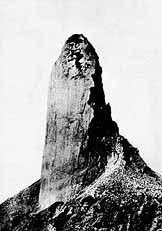 In October of that year,
a lava
dome
began to rise out of the crater floor. It grew for a solid year
into a gigantic shaft in the form of an obelisk. It has been described
by many as the most spectacular lava dome produced in historic
times. It was 350 to 500 feet thick at its base and it soared
to over 1000 feet above the base of the crater floor. It sometimes
rose at a remarkable rate, up to 50 ft/day. The huge spine of
lava became known as the "Tower of Pelée."
At night the sides of this magnificent monolith was marked by
traces of red incandescent cracks from the still hot lava in its
interior.
In October of that year,
a lava
dome
began to rise out of the crater floor. It grew for a solid year
into a gigantic shaft in the form of an obelisk. It has been described
by many as the most spectacular lava dome produced in historic
times. It was 350 to 500 feet thick at its base and it soared
to over 1000 feet above the base of the crater floor. It sometimes
rose at a remarkable rate, up to 50 ft/day. The huge spine of
lava became known as the "Tower of Pelée."
At night the sides of this magnificent monolith was marked by
traces of red incandescent cracks from the still hot lava in its
interior.
At its maximum size, the Tower of Pelée was twice the height of the Washington Monument and equal in volume to the Great Pyramid (Cheops) of Egypt. It finally became unstable and collapsed into a pile of rubble in March 1903, after 11 months of growth. No geologist had ever witnessed the emergence of such an object before.